 W
WHandheld electronic games are very small, portable devices for playing interactive electronic games, often miniaturized versions of video games. The controls, display and speakers are all part of a single unit. Rather than a general-purpose screen made up of a grid of small pixels, they usually have custom displays designed to play one game. This simplicity means they can be made as small as a smartwatch, and sometimes are. The visual output of these games can range from a few small light bulbs or LED lights to calculator-like alphanumerical screens; later these were mostly displaced by liquid crystal and vacuum fluorescent display screens with detailed images and in the case of VFD games, color. Handhelds' popularity was at its peak from the late 1970s into the early 1990s before declining. They are the precursors to the handheld game console.
 W
WAlien Attack is a 1979 handheld electronic game made by Coleco using a VFD display. It is housed in a bright orange, futuristic-styled case. The controls are a joystick, fire button, and move button. The player's ship can fire in any direction by moving the joystick with the fire button pressed. Movement only occurs when the move button is pressed. Firing while moving is not possible. There is a grid of barriers representing a city that the player can use for cover.
 W
WAntarctic Adventure is a video game developed by Konami in 1983 for the MSX, and later for video game consoles, such as the Family Computer and the ColecoVision. The player takes the role of an Antarctic penguin, racing to disparate research stations owned by different countries in Antarctica.
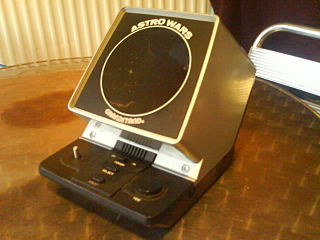 W
WAstro Wars was an electronic table top game made in Great Britain in 1981 by Grandstand under licence from Epoch Co., who sold the game in Japan under the title Super Galaxian (スーパーギャラクシアン), and in the United States as "Galaxy II" There were two versions of Astro Wars - an earlier version had the Astro Wars motif printed in red and a later version printed in white.
 W
WThe LCD Solarpower series are handheld electronic games powered by solar energy made by Bandai in 1982. The games in the Double Panel series feature two LCD panels stacked on top of each other. This allows these games to progress in 2 stages for more variation in game play.
 W
WBop It toys are a line of audio games. By following a series of commands issued through voice recordings produced by a speaker by the toy, which has multiple inputs including pressable buttons, pull handles, twisting cranks, spinnable wheels, flickable switches – the player progresses and the pace of the game increases.
 W
WBrain Warp is an electronic audio game designed and showcased by Big Monster Toys, and was manufactured and published by Tiger Electronics and released on June 16, 1996. In this game, players follow the spoken instructions from sound files spoken from the game unit. The player has to rotate the game in different directions so that the correct color is facing upwards. Its catchphrase which the voice says before a game begins is: "If you don't keep up with me, you're finished!". When you fail a game, the game unit will say "this game is finished" and then it will say "wanna warp again?". A Star Wars version titled Death Star Escape was released by Tiger Electronics in 1997 and the games are called Challenges.
 W
WBucky O'Hare is a fictional character and the hero of an eponymous comic book series as well as spin-off media including an animated TV series and various toys and video games. He was created by comic book writer Larry Hama and comic book artist Michael Golden between 1977 and 1978 and debuted to the public in Echo of Futurepast #1 in May 1984.
 W
WThe Dungeons & Dragons Computer Fantasy Game is a handheld electronic game released by Mattel in 1981.
 W
WElectronic Quarterback is a handheld electronic game made by Coleco in 1978. It is powered by a 9-volt battery or an AC adaptor, and it differentiated itself from the other similar handheld electronic football games of the era, notably Mattel Electronics's version, by having two blockers and giving the quarterback the ability to pass.
 W
WAdventure Vision is a cartridge-based video game console released by Entex Industries in either August or October 1982. The monitor, game controls, and computer hardware are all contained within a single portable unit. The LED monitor can only display red pixels. Four games were released, all of which are arcade ports.
 W
WFire Away was a series of handheld electronic games marketed by Tandy beginning in the 1980s. In all, there were six different products in the line, nearly all of which were actually licensed by Tandy rather than being original Tandy games. The games looked to capitalize on the popularity of the video game Space Invaders which was released in 1978.
 W
WGalaxian 2 is a handheld electronic game that was released in 1981 in the US by Entex Industries. It was also released the same year in Japan under the name Astro Galaxy and in Europe under the name Astro Invader. The game was also released under the Futuretronics brand in Australia.
 W
WGame & Watch: Super Mario Bros. is a limited-edition Game & Watch game developed and published by Nintendo, released on November 13, 2020. The game is a compilation of three prior Nintendo games, Super Mario Bros., Super Mario Bros.: The Lost Levels, and Ball. The game was released to commemorate the 35th anniversary of the Super Mario series, as well as the 40th year anniversary of the Game & Watch line of systems.
 W
WThe Game & Watch brand is a series of handheld electronic games developed, manufactured, released and marketed by Nintendo from 1980 to 1991. Created by game designer Gunpei Yokoi, the product derived its name from its featuring a single game as well as a clock on an LCD screen. The models from 1981 onwards featured an alarm in addition. The series sold a combined 43.4 million units worldwide, and was the earliest Nintendo video game product to gain major success.
 W
WLaden VS USA is a LCD handheld electronic game supposedly created by Chinese company Panyu Gaming Electronic Co. Ltd.. It is unknown if the company actually manufactured the game due to mass counterfeiting in China. Laden VS USA was also released in two different designs. The game is based on the 9/11 attacks and features pictures of the actual wreckage on the packaging. Laden VS USA also bears the marks of "Made in China" and "Ages 5 and Up" on the packaging.
 W
WMario's Cement Factory is a 1983 LCD game developed and published by Nintendo under their Game & Watch series. It follows earlier Mario games, like the arcade and Game & Watch versions of Donkey Kong. The player controls Mario as he navigates elevators and funnels cement through a factory, while trying to prevent the cement from crushing his fellow workers. Two versions of the game were released — one being a tabletop unit and the other being a handheld game akin to most other Game & Watch titles.
 W
WMattel Electronics Auto Race is the first in the line of many Mattel Electronics games, and is credited with being the first handheld game that was entirely digital, with only solid-state electronics, having no moving mechanisms except the controls and on/off switch.
 W
WMerlin is a handheld electronic game first made by Parker Brothers in 1978.
 W
WMilton is an electronic talking game. According to the patent, Milton was the first electronic talking game that allowed two people to play against each other. Previously released devices of this type, such as Speak & Spell by Texas Instruments, were known primarily as teaching devices rather than competitive games.
 W
WMini-Munchman is a handheld electronic game that was released in 1981 in the UK by Grandstand. The game is a rebadged version of Epoch-Man from Epoch. In some markets such as Australia the game was badged "Mini-ARCADE".
 W
WMunchman is a tabletop electronic game that was released under licence in 1981 in the UK by Grandstand. It is a rebadged version of the Tomy game known as Pac Man in the United States and Puck Man in Japan.
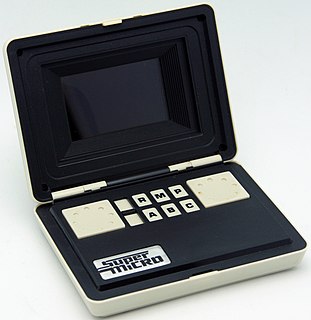 W
WThe Palmtex Portable Videogame System (PVS), later renamed and released as the Super Micro and distributed under the Home Computer Software name, is a handheld game console developed and manufactured by Palmtex, released in 1984.
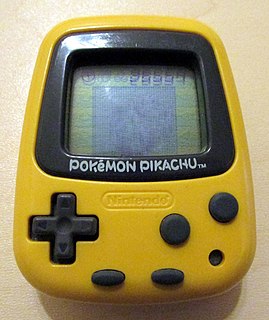 W
WPokémon Pikachu, also known as Pocket Pikachu (ポケットピカチュウ) in Japan, is a limited series of two portable Pokémon digital pets featuring the famous yellow electric-type Pokémon, Pikachu. Released on March 27, 1998, in Japan, it was intended as an exercise toy and mentioned by Guinness World Records as the most popular exercise toy of its time.
 W
WThe Rubik's Revolution is a handheld electronic game invented, designed, developed and patented by Rehco, LLC, a Chicago toy and game inventing firm. The Rubik's Revolution was formerly distributed by Techno Source and received the 2008 TOTY Game of the Year Award. Designed to resemble the classic Rubik's Cube puzzle, the device is a single rigid cube; it is about as large as a Professor's Cube, with each face subdivided into 9 square sub-faces. The center square of each face features a recessed LED-lit button colored to correspond with the stickers on the remaining squares. Gameplay involves pressing the buttons when they light up, or when directed to by the game's recorded voice.
 W
WSimon is an electronic game of memory skill invented by Ralph H. Baer and Howard J. Morrison, working for toy design firm Marvin Glass and Associates, with software programming by Lenny Cope. The device creates a series of tones and lights and requires a user to repeat the sequence. If the user succeeds, the series becomes progressively longer and more complex. Once the user fails or the time limit runs out, the game is over. The original version was manufactured and distributed by Milton Bradley and later by Hasbro after it took over Milton Bradley. Much of the assembly language code was written by Charles Kapps, who taught computer science at Temple University and also wrote one of the first books on the theory of computer programming. Simon was launched in 1978 at Studio 54 in New York City and was an immediate success, becoming a pop culture symbol of the 1970s and 1980s.
 W
WThe Speak & Spell line is a series of electronic hand-held child computers by Texas Instruments that consisted of a TMC0280 linear predictive coding speech synthesizer, a keyboard, and a receptor slot to receive one of a collection of ROM game library modules. The first Speak & Spell was introduced at the summer Consumer Electronics Show in June 1978, making it one of the earliest handheld electronic devices with a visual display to use interchangeable game cartridges. The company Basic Fun brought the classic speak and spell back in 2019 although with some minor changes
 W
WSuper Cobra is a horizontally scrolling shooter developed by Konami, originally released as a coin-operated arcade game in 1981. It was published by Konami in Japan in March 1981, and manufactured and distributed by Stern in North America on June 22, 1981. It is the prequel to 1981's Scramble arcade game.
 W
WThe Tandy-12 is a computerized arcade game produced by the Tandy Corporation for sale in its Radio Shack chain of stores. The Tandy Corporation acquired Radioshack in 1970. The arcade game featured "12 challenging games of skill". However, most of these were based on luck and freestyle ability. The game had its packaging updated several times since its original release. It was packaged with the game unit itself, a manual, a cardboard playing board, and a set of plastic tokens. The manual is available online. The 1981 Tandy-12 Model number is 60-2159. The 1982 Tandy-12 Model number is 60-2159.
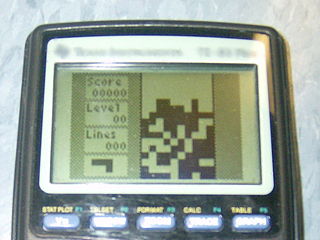 W
WThis is a list of variants of the game Tetris. It includes officially licensed Tetris sequels, as well as unofficial clones.
 W
WTouch Me is an arcade game first released by Atari Inc. in 1974, and later as a handheld game in 1978. It can be described as a Simon-like game that involves touching a series of buttons that light up and produce sounds. The player must observe a sequence of blinking electric lights and repeat the sequence back in the same order that it occurred. Each time this is completed, the game will produce another sequence with an additional button added. This process is repeated and a digital score window displays the total number of sound sequences a player correctly repeats. The game continues until the maximum sequence of buttons is reached, or the user makes a mistake.
 W
WTurtles is a video game developed by Konami and published in arcades in 1981 by Stern and Sega. The Sega version was published as Turpin (ターピン). Turtles is a maze game where the player is a turtle trying to bring baby turtles to their homes while avoiding beetles.
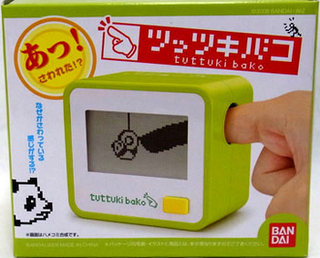 W
WTuttuki Bako (ツッツキバコ) is a roughly cubic hand-held electronic game created by Bandai in 2008. The game comprises five mini-games, and a resettable alarm clock. While the minigames are rather simplistic, Tuttuki Bako has received international acclaim for its unique means of control and the game has been put forward as an archetypal example of Akiba-kei and Japanese gadgetry in general.
 W
W